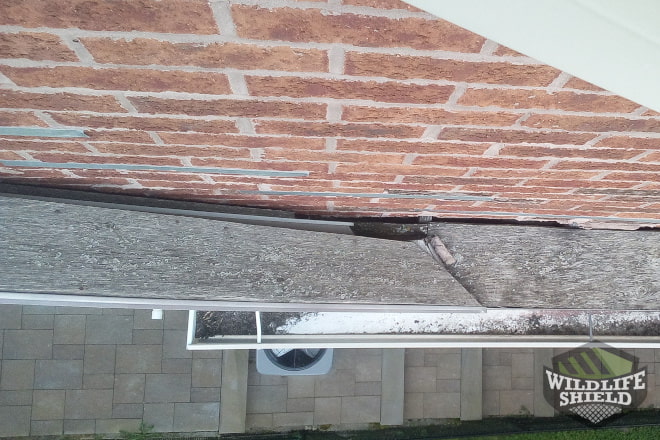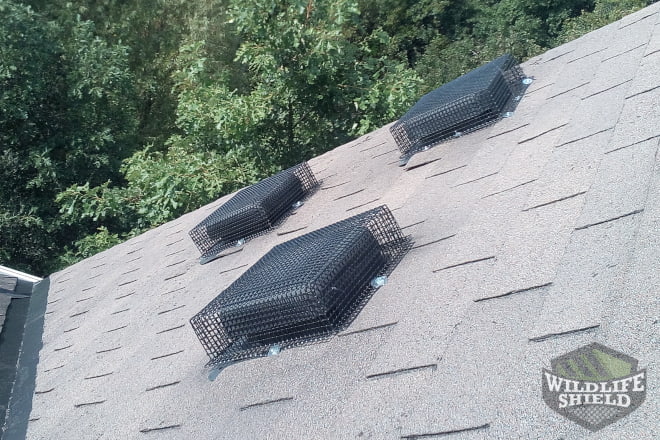The following case study details a squirrel removal job in Whitby, Ontario. A squirrel broke into the attic of a single-family home, repeatedly, causing damage on the sides of the roof. With the help of our technicians, the squirrel was removed humanely, and kept out by excluding every possible entry point. Cases like these are common. Give us a call if you are facing a squirrel problem. We provide safe and humane squirrel removal services across the Greater Toronto Area.
Inspection
The homeowner in this case gave us a call when they heard noises coming from the attic. It was mid-August, and they could hear scratching and thumping sounds during the day. This is a common sign of a squirrel invasion. Females come nesting in attics in late summer, then make a lot of noise during the day as they build their nests. Unsure of exactly where the squirrel was, the homeowners suspected that it was nesting near a vent in the wall. A technician quickly came to investigate.
The first things our technicians do, no matter the situation, is to perform an inspection. This identifies the animals’ entry points and every other vulnerability on the property. A thorough inspection allows us to provide the best possible service.
Here, the technician found the squirrel’s entry point where one part of the roof met the soffits above. The structure was made of wood and a squirrel chewed its way through. Squirrels have very sharp teeth. If they find an opening in the roof, they may chew it wider to reach the interior.
In addition to the entry point, the technician noted that there was 20 feet of gaps along the metal flashing on the edges of the roof, which could let in more squirrels. There were 8 roof vents as well, and 8 roof-soffit intersections that were vulnerable to squirrels.

When the technician came down from the roof, he recommended having a one-way door installed to the squirrel’s entry point, then protecting the other vulnerabilities with mesh or metal flashing. The one-way door would let the squirrel leave on its own. Once out, it would be unable to get back inside. The homeowner agreed to have the work done as soon as possible.
Removal and Exclusion
Since most of this work would take place on the top of a two-story home, a second technician came to the scene. Safety is our number one priority. In many cases, we need two technicians present to ensure that the work is done safely.
First a technician installed the one-way door to the entrance in the roof. This consists of a mesh tube, much like an open-ended trap, which lets the animal out safely. The mesh we use is too thick and strong to be chewed through, so it works perfectly for squirrels.

Following the one-way door, the technicians put metal flashing along the edges of the roof where there were gaps. This would keep rain and wildlife from getting inside. Then, the intersections where the soffits met the roof below were strengthened with mesh. Roof-soffit intersections are vulnerable to wildlife because animals can sit on the roof while they chew or push their way through the soffits.

Finally, the roof vents were covered in mesh. Roof vents like these are made of plastic, which can be chewed by rodents. Raccoons are also strong enough to tear these right off. Covering them with mesh prevents wildlife from using them as opportunities to nest in the attic. It’s a small investment that can go a long way.

Once the exclusion was done, the technicians told the homeowner to wait a few weeks for the squirrels to leave. The technicians would then return to remove the door and replace it with mesh.

Follow-up
The following spring, the homeowner called us back to say that they could hear animals in the attic again. The squirrel that was there in August was removed just fine, but it seemed that another animal broke in.
A technician came the following day to investigate and found a small gap in the metal flashing that our team had installed. A gap between sheets of metal was used to get inside the roof. To remove the squirrel, he would install a one-way door right on the flashing. The homeowner agreed to have this done. Given our warranty, all of this was done for free. If animals break through out work, we come back and fix it.

A few weeks later, the squirrel was gone. Once out, a technician returned to the property and replaced the door with mesh. Squirrels are determined little creatures. Something about this roof was very attractive to them and they wanted to nest inside. Excluding the roof and reinforcing this weak spot kept the squirrels out for good.

Conclusion
Squirrels are crafty little animals with very sharp teeth. If they see an opening to a place where they want to nest, they can chew their way through. Call us if you suspect that some animals have broken into your attic or if you are interested in having your property protected from wildlife. We can remove the animals humanely, then keep them out by excluding the roof. Call us today for an inspection.